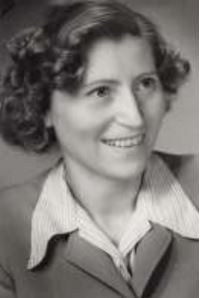Irma Trksak
02.10.1917 (Vienna) – 11.07.2017 (Vienna),
Teacher, Slavic student, secretary, clerk
Ravensbrück: 02. October 1942 – KZ Uckermark - Ravensbrück until 29. April 1945

Irma Trksak, 1947, Wien, Foto: MGR/SBG, Nr. 98/55
After the "Anschluss" of Austria to fascist Germany (1938), the Czech Komensky elementary school, where Irma teaches - like all Czech schools in Vienna - was closed in 1940. Irma begins studying Slavic studies at the University of Vienna.
The classification and suppression of the Czech minority as "racially inferior" particularly afflicted her. During this time, she began her resistance actions in a censorship office for letters in Slavic languages and in her group in the "Czechoslovakian gymnastics club".
The meetings in the club were a good cover for the resistance activities. Leaflets about Germany's war intentions were written. Young men were invited in after the war began to evade the draft. Irma and her friend helped to reproduce and distribute the leaflets. Both also participated in acts of sabotage.
Irma was arrested on September 29, 1941, and her boyfriend a day later. On October 2, 1942, she was brought to Ravensbrück together with 12 other women from the Czech resistance group.
The 13 Czechs have a blessing in disguise. After some time in the access block, they are included in the "model block" for political prisoners. Rosa Jochmann is the block elder there. There you help each other, show solidarity with each other. But that doesn't change the terrible living conditions.
Irma had to work for SIEMENS, which had a production facility near the warehouse because of the cheap labor. She had to draw diagrams according to the work done by women. In doing so, she tried to protect weaker prisoners with beautified statistics. In 1944 she became the elder of the room in her own “warehouse” right next to the company premises. In “her” room she promoted cultural activities and tolerated political discussions - and was betrayed. Thereupon she was transferred to the Uckermark camp as the elder.
On April 29, 1945, Irma and her friends managed to escape the death march.
Immediately after her return to Vienna in early summer 1945, Irma Trksak was one of the authors of the first publication on the "Ravensbrück Women's Concentration Camp". Eleven women from Ravensbrück described the "women's dungeon in Europe". According to the authors, "a short, simple report of the immeasurable, inexhaustible suffering that fascism has brought us." The booklet was published in 1945 by Stern-Verlag Wien.
Once home she learned that her brothers in the concentration camp and at the front had been killed and her childhood friend had died in a sub-camp of Mauthausen.
She is disappointed because nobody wants to hear the horrific experiences of the concentration camp survivors. She feels in good hands in the camp community. She was involved in the Austrian camp community for many years and was delegated to the IRK by it. She spoke as a contemporary witness in schools and universities until old age.
Sources: Traude Bollauf: „Wir wollten, dass jemand von uns überlebt, damit wir alles bezeugen können“ – Irma Trksak in: Helga Amesberger / Brigitte Halbmayr (Hg): „Vom Leben und Überleben – Wege nach Ravensbrück. Das Frauenkonzentrationslager in der Erinnerung“, Band 2 – Lebensgeschichten, 2001 Promedia, Wien, S. 229-236, (ISBN 3-85371-176-6)